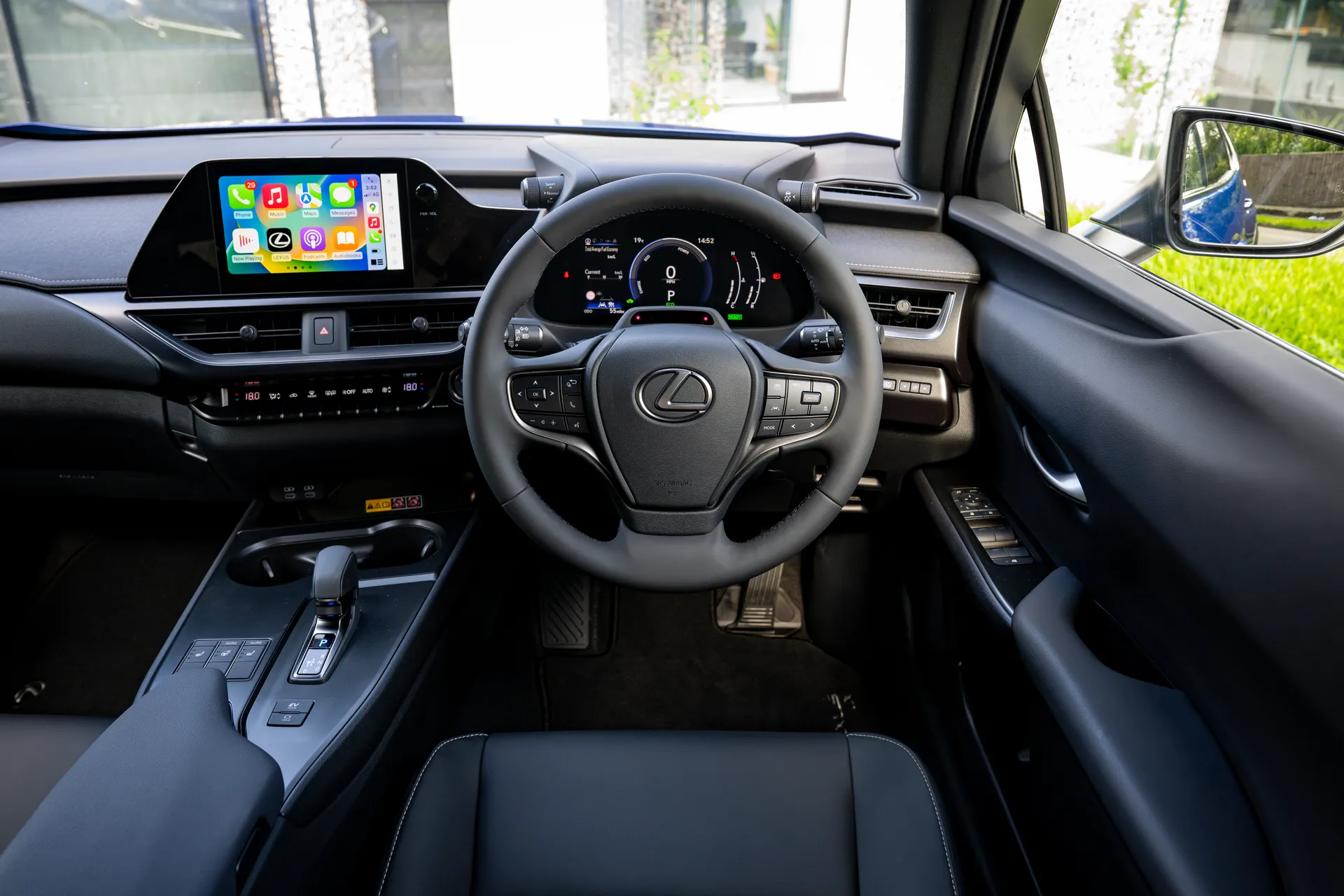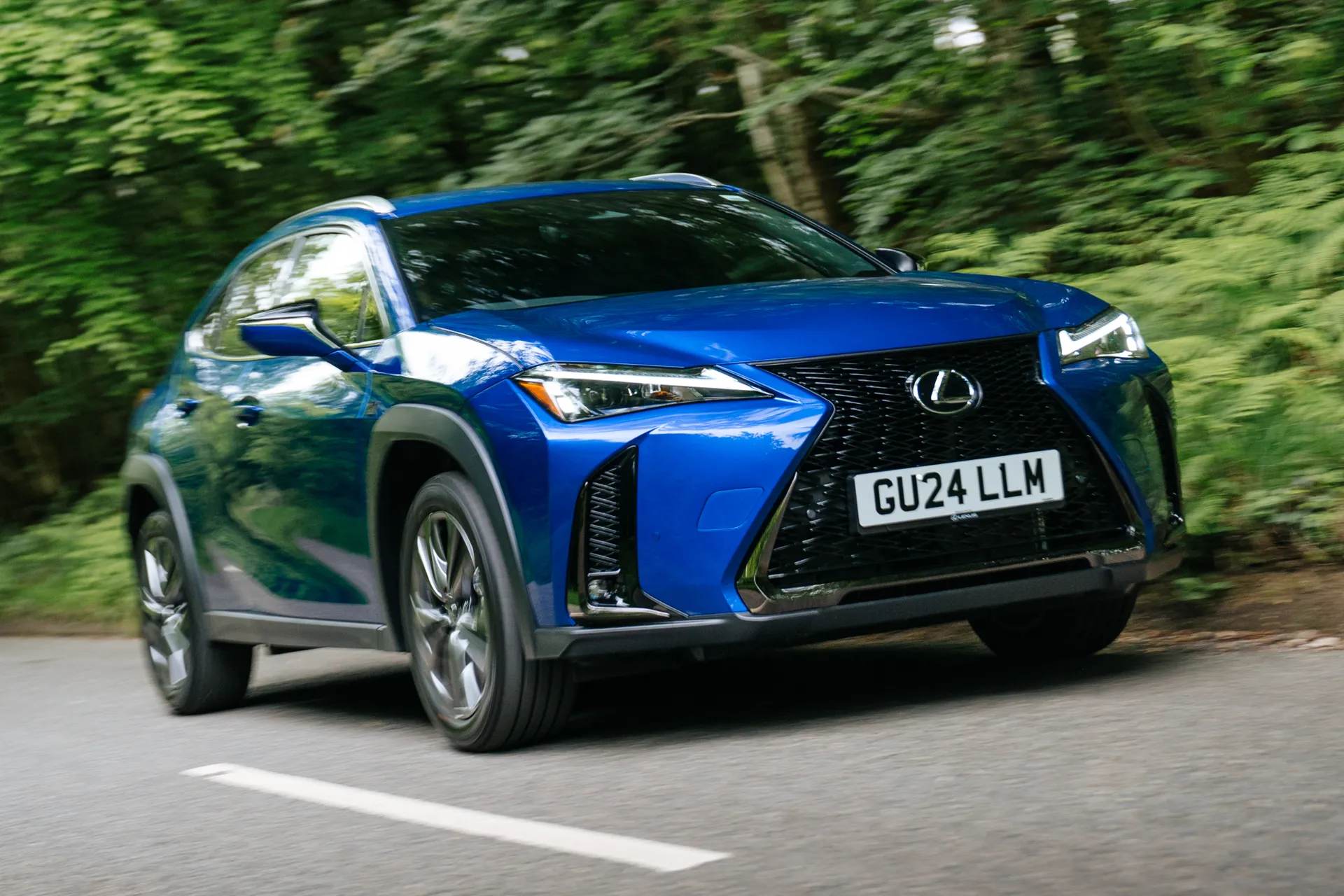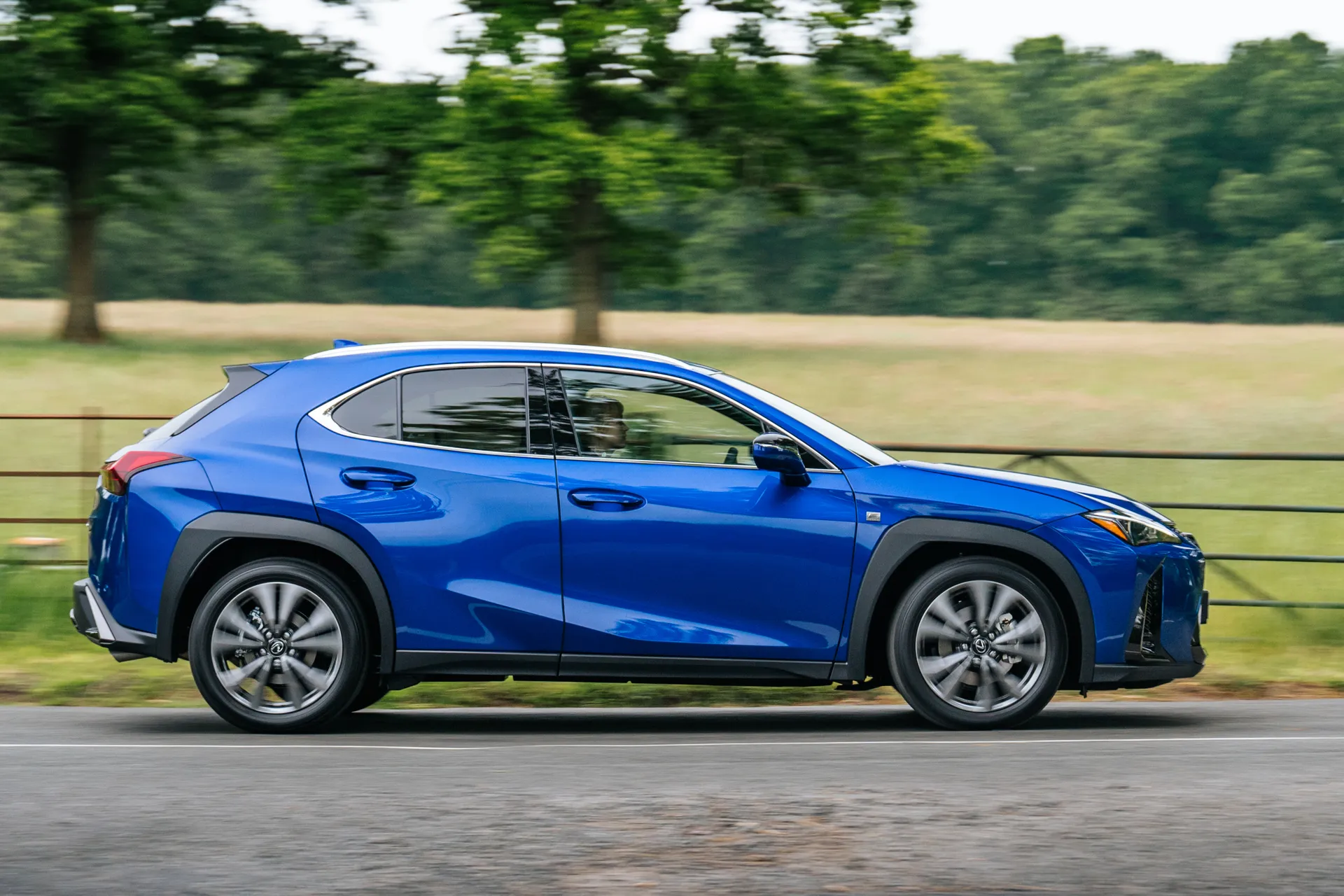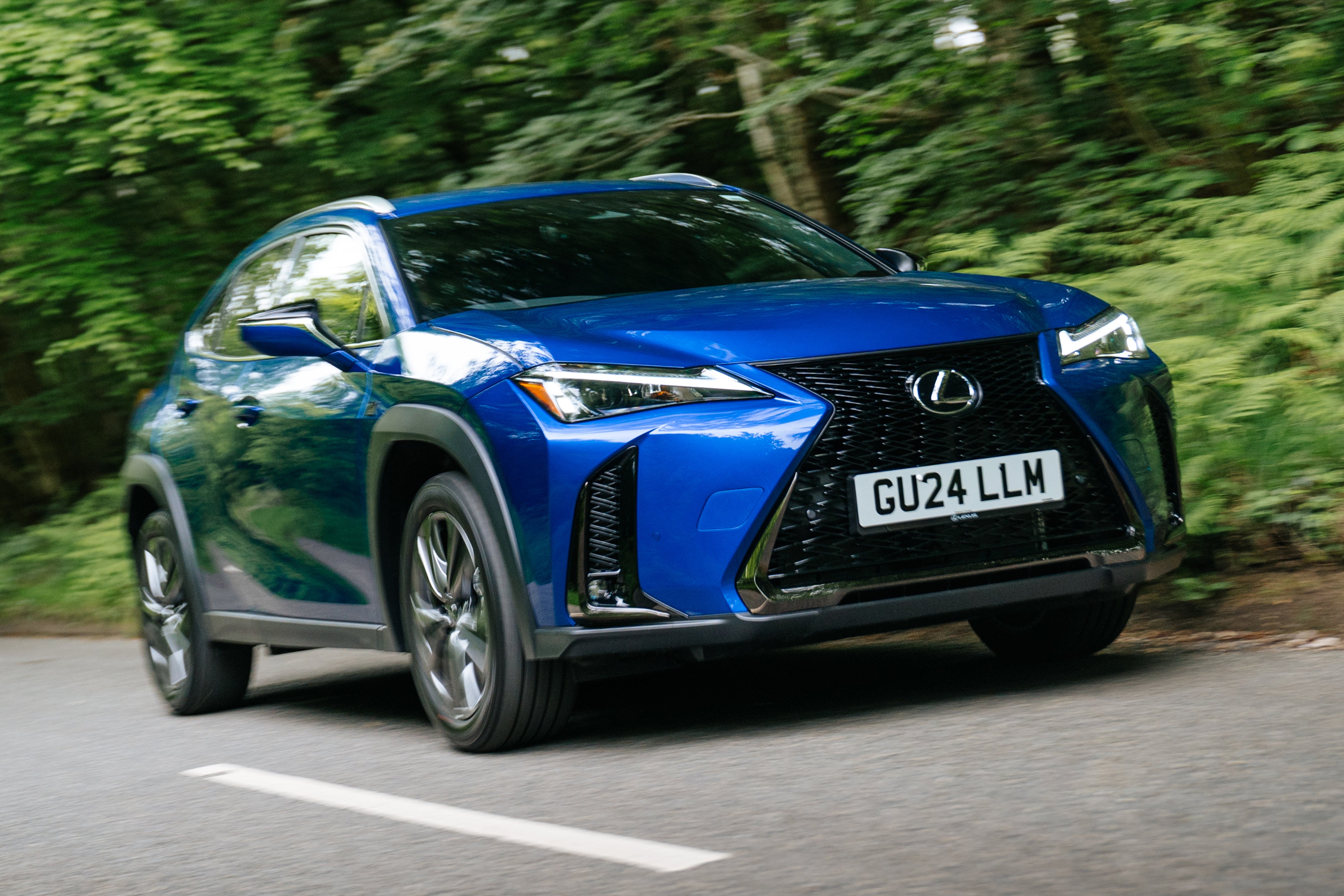Lexus UX Review 2025: Price, specs & boot space
Written by Phil Hall
Quick overview
Pros
- Sips fuel in town
- High quality cabin
- Excellent reputation for reliability
Cons
- Not a lot of space for luggage or rear-seat passengers
- Infotainment system is far from the best
- Pretty useless at towing
Overall verdict on the Lexus UX
"The Lexus UX is a posh small SUV that's more relevant than ever thanks to its hybrid engine line-up and all-electric relation in the form of the UX 300e. While it might lack some of the kerb appeal of a Mercedes GLA or Volvo XC40, the stylish cabin and brand's reputation for dependability mean it's actually a really worthy choice for the SUV buyer willing to look beyond the obvious candidates."

The small premium SUV market is bursting with some very strong competition as seen in our Lexus UX review. With a wealth of options in this class the UX stands against the likes of the Mercedes GLA or Volvo XC40 mentioned above. And you could consider the BMW X2, Range Rover Evoque, Jaguar E-Pace, Audi Q3 and maybe even the Alfa Romeo Tonale.
To stand out in this segment, the Lexus UX really needs to do something special. In that respect, it kind of fails. Many buyers would prefer an Audi or Mercedes badge on the front of their small SUV, while the design of the Lexus UX isn't going to attract admiring glances in the same way a Volvo XC40 or BMW X2 might.
Its USP, though, is found under the skin. The Lexus UX's mechanical bits are shared with the Toyota Corolla and Toyota C-HR – neither are particularly exciting, admittedly, but ownership surveys consistently rank them as two of the most reliable, efficient cars money can buy. And in the age of rising fuel costs and ever more complex cars, there's a lot to be said for high dependability and low running costs.
The only engine choice – aside from the fully electric Lexus UX300e – is now badged the UX300H (formerly the UX250h). This is a hybrid set-up which pairs a 2.0-litre petrol unit with an electric motor. There's also a four-wheel-drive model, which adds an extra electric motor to power the rear wheels, but few buyers consider this worthy of the knock in efficiency (not to mention the increased list price).
The Lexus UX is a pleasant car to drive around town. The engine has the ability to switch off entirely for short periods, allowing you to coast around in silence (the UX300e is worth a look if you'd like to do more of that). It's the kind of car that isolates you from your surroundings, leaving you totally relaxed even after negotiating a congested city centre. The light controls add to the laid-back vibe, while it's worth hunting out one with the reversing camera to aid bump-free parking.
There's enough grunt for accelerating to motorway speeds, although planting the accelerator pedal into the floor will trigger a noticeable drone from the engine thanks to the E-CVT transmission. You're much better building speed gently and revelling in the UX's impressive fuel economy (officially it'll return up to 53.3mpg and we saw close to that with our time with the car). Of course, the UX300e is much quieter as it has not combustion engine to deal with.
At higher speeds, you might notice a bit more wind and road noise making its way into the cabin than you might otherwise expect. The light steering doesn't provide as much confidence as the more communicative setup you'd find in a BMW X2, either, while the heavy batteries mean it thumps a little over potholes. A Volvo XC40 on small wheels is a softer, more comfortable choice
The Lexus UX feels like a high-quality product inside, though. There are no rattles and squeaks, trim pieces have consistent gaps and the design is smart to look at. There's nothing flash about the cabin but it looks, feels and even smells like a premium place to be.
The tricky infotainment system is more of an issue. It uses a touchpad control in between the two front seats which require a Crystal Maze winning level of hand-eye coordination just to use it. That said, Apple CarPlay and Android Auto come as standard so you can avoid the car’s controls and use your phone’s voice activation system instead.
What’s harder to get past is the fact that the Lexus isn’t that practical for an SUV. Sure, the front seats are spacious but jump in the back and even average-sized adults will find themselves stuck for knee room and dreaming of larger rear windows that make the Lexus feel less claustrophobic. Factor in the incredibly shallow boot and, if you’re looking for a practical posh SUV, you are much better off with any of the Lexus’s competitors.
If you don’t need acres of space, though, there’s much to like about the UX. Its otherworldly body styling hides a hybrid engine deserving of the looks and capable of spectacular in-town fuel economy, and it’s a very relaxing car to drive. If that all sounds up your street then it’s worth breaking from the flock and considering the Lexus UX.
Looking for a used car for sale? We've got 100s of Lexus Approved Used Cars for Sale for you to choose from, including a wide range of Lexus UX cars for sale.
Is the Lexus UX right for you?
The Lexus UX is right for you if you want a hybrid SUV that’s cheap to run and relaxing to drive in town – it does this better than any of its rivals.
Rivals like the BMW X2 are more fun to drive. The Lexus is not that spacious inside, but it does feel well-built and you get plenty of standard equipment – including Apple CarPlay and Android Auto – which makes up for the lacklustre performance of the standard infotainment system.
What's the best Lexus UX model/engine to choose?
Answering the first half of that question is simple – the Lexus UX300H and UX300e are only available with one engine in each version, a petrol-electric hybrid that’s frugal on fuel for the UX300H and a 204PS electric motor in the UX300E. That said, we’d avoid the specifying the optional four-wheel drive version of the hybrid which is largely pointless in a car you’ll probably never take off-road. The EV model is only available with two-wheel drive.
There’s more to consider when it comes to trim levels - lots more in the case of the UX300H that has eight trims to pick from. Money no object, we wouldn't hesitate to recommend the Takumi model with its fancy Mark Levinson surround sound system, 12.3-inch navigation display and ventilated front seats. Even the most affordable Lexus UX is well-equipped, though, while the F Sport model adds a few desirable touches.
What other cars are similar to the Lexus UX?
The question should almost be 'What other cars aren't similar to the Lexus UX?' as there are so many cars like this to choose from.
Among the toughest rivals for the Lexus is the BMW X1 that is a great all-rounder. It looks smart, is posh inside and also a lot more practical than the Lexus. Sure, it can't compete with the Lexus UX's in-town fuel economy, but it’s a more well-rounded package out of town and diesel models are still very cheap to run.
Fancy something more comfortable, then consider the Range Rover Evoque. Its suspension soaks up bumps better than the Lexus’ and it’s also quieter in town. It’s also better off road and a more accomplished tow car.
Comfort and design: Lexus UX interior
"The Lexus UX’s interior is quite different to what you’ll find in a BMW, Mercedes or Audi SUV."

Instead of the homogeneous design you get in the German cars, the Lexus’ cabin serves up a mix of shapes and textures with a dashboard that points towards you.
It has a central infotainment screen that sits right in your eye line and below it, a classy piece of trim runs the length of the dashboard split by the Lexus’ pod-like instrument binnacle. You get conventional buttons for the ventilation system and buttons on the steering wheel for the stereo.
The downside of the unique approach is the Lexus has controls you won’t find in other cars, like the secondary stalks that sprout out of the sides of the instrument binnacle and a strange touchpad control for the infotainment system. More on that later.
If you’re expecting the Lexus to have a high-set driving position like a BMW X1 or Audi Q3 then you’ll be surprised. It’s barely taller than a normal car and, while we’re on the subject, rearward visibility isn’t great.
Getting a comfortable driving position shouldn’t be an issue, mind. Okay, so the steering wheel could move further towards you, but it has plenty of height adjustment, as does the driver’s seat.
Standard UX models get a six-way manual adjustment for the driver’s seat, while F Sport cars and above get eight-way electrically adjustable and heated front seats with lumbar support. Takumi versions go another step further with ventilated seats that have a memory function so you can save your exact setup if someone else uses the car.
Quality and finish
There’s no denying the Lexus UX is solidly constructed. Main plastics feel like they’d withstand a nuclear strike, gaps between materials are consistent, and there are no squeaks or rattles.
Despite this, there's a lack of consistency in the finish of materials used. Sure, you find nice materials on the dashboard and door tops but the further down you poke the cheaper the plastics seem to be. By comparison, a BMW X1 feels more consistently well-built.
Perceived quality improves depending on what model you go for. The standard UX makes do with fabric seats that look fine, so long as you avoid the Cobalt (blue and white) colour scheme.
F Sport models get posher looking Tahara Fabric seats (available in a range of tasteful and not so tasteful colour schemes) and sport aluminium pedals.
Top-of-the-range Lexus UX Takumi models trump the lot, though. They have a leather interior as standard and also get a Washi Paper inspired centre console trim.
Infotainment: Touchscreen, USB, nav and stereo in the Lexus UX
As standard, the Lexus UX comes with an 8.0-inch central screen (that used to be a 7.0-inch item) which is smaller than you get in most rivals and also features clunky, old-school graphics that look dated compared to what you get in a BMW, Audi or Mercedes.
While the graphics aren’t great, the biggest problem with the infotainment screen is its touchpad controller. In theory, it should allow you to control the screen without having to take your eyes off the road.
The reality, though, is that the cursor is extremely hard to control accurately, especially when you’re focused on driving, and the menus are also confusingly laid out and not very intuitive. To be honest, a good touchscreen is easier to operate, while a BMW-style rotary controller is vastly more user-friendly on the move.
All in all, you’re much better off heading straight for the car’s Apple CarPlay or Android Auto systems. They mirror your smartphone’s display – for things like sat-nav and music playback – using your phone’s more intuitive menus and voice activation system.
Lexus UX F Sport models get a revised instrument binnacle with an analogue rev counter that moves electrically to reveal a digital display hidden behind. This is a very neat touch and a detail that helps lift the UX's cabin.
For a proper infotainment upgrade, though, you’ll need the Premium Plus or higher trims with the UX300H to get a 10.3-inch central display as standard (this used to be a 10.3-inch size) and built-in sat-nav, although the graphics are no clearer than the standard system’s. As well as the larger screen, Takumi cars also add a head-up display that can project important information – such as speed and sat-nav directions – onto the car’s windscreen. With the UX300e, only the Takumi model has this larger infotainment screen.
As well as upgrading the infotainment system, Takumi cars also swap the standard car’s decent six-speaker stereo for a Mark Levinson system. It has 13 speakers and sound quality that even the stereos fitted to luxury cars – such as the Mercedes S-Class – struggle to better.
Space and practicality: Lexus UX boot space
Adults aren’t going to feel short of space up front in the Lexus UX, and both you and your front-seat passenger’s seat has height adjustment.
The electrical adjustment on F Sport models makes it less of an effort to get the seat just how you want it, and it also comes with robust lumbar support, heated seats and a heated steering wheel. Takumi models go a step further by adding ventilated front seats that send a cooling breeze up your legs and back on sticky summer days.
Unfortunately, you don’t get that luxury in the back. Anyone above average height will feel their knees pressing hard on the seats in front and there’s not a lot of foot room, either. Okay, so headroom’s okay, but the small windows make the back seat feel dark and dingy. On a positive note, you do at least get a rear centre armrest with two cup holders - big deal, eh?
The Lexus UX isn’t great with three people in the back. You'll feel plain crushed and your mates in the outer seats will find their heads being pressed up against the roof. It's not even as roomy as smaller family hatchbacks.
The limited space also makes its presence felt when you fit a child seat. The small rear doors don’t open that wide, hampering access and manoeuvring the chair into position is tricky with such limited room behind the front seat. On the upside, the Isofix points are marked behind removable plastic covers.
What’s not so good (again) is the Lexus UX's tiny boot – at 320-litres, it’s nearly 20% smaller than you get in a Volkswagen Golf and miles off the 530-litres you get in a comparable SUV such as the Audi Q3. The UX300E is marginally better with 367-litres of boot space.
However, there’s worse to come when you see the boot’s shape, though. It’s very shallow so you can forget about sticking your Labrador in there and, although there’s no boot lip, the boot itself sits very high which makes loading heavy luggage a pain. Sure, you get storage areas under the floor (except in four-wheel-drive models, where space is taken up by an electric motor) but, with no spare wheel, that’s not a surprise.
In terms of dimensions the Lexus UX is 1540mm tall, 2078 wide (with wing mirrors out) and 4495mm long.
Handling and ride quality: What is the Lexus UX like to drive?
"In town, the Lexus will happily bimble about using electricity alone. It’s almost silent and will happily take the UX up to 30mph. It'll only do this for short journeys, though."

The Lexus UX300H is not a plug-in hybrid so the electric-only range is negligible (a mile or two at best) but when the petrol motor does cut in, more often than not it’s only acting as a generator and barely ticking over. It’s only when you need a sharp burst of acceleration that the petrol engine will make itself noticeable.
It’s not just the engine that makes the Lexus UX an excellent town car. It’s got an automatic gearbox as standard so you don’t need to worry about the clutch pedal, you’ll not get knackered twiddling the light steering and the UX’s raised suspension and meaty tyres means you don’t need to worry about damaging the car on speed humps and potholes.
Okay, so the rearward visibility isn’t great, but reverse parking is helped by the standard rear-view camera and if you go for the Driver Assistance Pack you get front and rear parking sensors, while top-of-the-range Takumi models have a 360-degree camera.
Out of town, the Lexus starts to feel like it’s less in its comfort zone. It’s not great at absorbing bumps at slower speeds and on the motorway, it fidgets over expansion joints and surface changes. Large bumps, meanwhile, can feel quite sharp, especially in F Sport and Takumi cars which are fitted with larger 18-inch wheels.
The engine noise under acceleration is worse, too. Instead of going through the gears as the engine’s tone rises and falls like a normal auto, the Lexus CVT essentially has one gear that gets larger and smaller as required, with the engine holding a constant speed. All of which means that, under prolonged acceleration, the Lexus emits a steady, aggressive engine note that quickly becomes an annoying drone.
None of that applies to the UX300E, which is very quiet on the move and is equally easy to pilot around town or on more open roads.
On country roads, this also means there’s not much fun to be had working either UX hard. Which is fine because the light steering and significant body roll mean you’re unlikely to be trying hard in corners anyway.
Even with the optional Adaptive Variable Suspension fitted to F Sport models – which allows you to stiffen the car’s dampers from more control – the Lexus doesn’t get close to being as fun to drive as a BMW X1.
And what of the four-wheel-drive system? Well, it’ll give you extra grip on slippery roads, but doesn’t turn the low-slung UX into an off-road hero and its maximum towing capacity of just 750kg is less than half a Range Rover Evoque can manage.
What engines and gearboxes are available in the Lexus UX?
Despite the 300H badge (or the earlier 250h), the Lexus UX uses the same 2.0-litre self-charging system as found in the Toyota Corolla and not the 2.5-litre from the Toyota RAV4. Not that it's any poorer for using the smaller engine. We think the 2.0-litre is the better hybrid.
When it comes to hybrids, Toyota has more experience than any other manufacturer and it shows. The UX is incredibly smooth. You pull away in electric power and the engine kicks in when needed. However, the transition is so polished, you will hardly notice.
There are no problems with performance when the UX is driven in standard hybrid mode. It's never short on power and accelerates with plenty of gusto if required, getting from 0-62mph in 8.5 seconds. It's just not particularly quiet when doing so.
Then there's the UX300e that has a 204PS electric motor driving only the front wheels. It's good for 0-62mph in 7.5 seconds, so it's brisker than its hybrid sister. Like most EVs, the power comes in strongly from as standstill and only really tails off once you're up to around 60mph.
Refinement and noise levels
The Lexus UX’s hybrid powertrain’s ability to run on electric power alone makes it very quiet in town, but while it'll officially switch into electric mode at up to 70mph you'll find it difficult to keep it there right up to that point even with a gentle right foot. Once coasting, though, it'll kick the engine off quickly.
As we've mentioned, under hard acceleration the Lexus UX does get a bit raucous, although that's a common quirk associated with CVT-equipped hybrids. More gentle acceleration isn't as disruptive.
One oddity is the Active Sound Control fitted to F Sport models and above, which actively amplifies the engine noise using a loudspeaker hidden in the dashboard, it’ll even fake engine noise when you’re in full electric mode. It’s controlled using a dedicated volume button.
With the UX300e, it's much quieter in every given situation thank to almost no noise from its motor.
Unfortunately, the news isn’t so good in other areas. The Lexus UX in both forms suffers from more wind noise than the Audi Q3 – with noticeable flutter around its wing mirrors – and you’ll hear quite a lot of tyre rumble, too, especially in F Sport and Takumi models that have the larger 18-inch alloy wheels.
Safety equipment: How safe is the Lexus UX?
The Lexus UX was awarded five stars for safety when it was crash tested under Euro NCAP’s extremely tough 2019 test conditions.
Even standard UX models come with plenty of safety kit. You get active cruise control that can brake and accelerate the car on the motorway and automatic emergency brakes that can detect cars as well as pedestrians and cyclists.
To that lot you can add bright-shining, auto-dipping LED headlights, lane-keep assist and road-sign recognition which display roadside information – like the current speed limit – onto the car’s big screen.
Top-of-the-range Takumi models have even more safety kit. They get upgraded LED headlights, swapping the bi-LED lights fitted to the rest of the range for more powerful 3-eye LED headlights that give you a larger field of vision and are also better at cutting through fog.
On top of that, you get a Blind Spot Monitor system that’ll warn when a car is hidden in your blind spot on the motorway and Rear Cross Traffic alert which will sound a warning before braking the car if you try to pull out in front of traffic from a perpendicular parking space.
MPG and fuel costs: What does a Lexus UX cost to run?
"Capable of more than 50mpg, the Lexus UX will be a very affordable SUV to run. Avoid the four-wheel-drive versions, though, as they'll see real-world fuel economy drop to mid-40s at best."

The Lexus UX's frugality is most impressive in town where even the most economical diesel SUV's fuel economy will drop like a stone. In the Lexus, though, it stays steady, with the ability to run on electric power alone paying dividends and the stop-start nature of city driving allowing the UX to recoup maximum energy via its regenerative brakes.
It's perhaps not quite as economical at motorway speeds but, during our period with the car, we still saw impressive fuel economy on the trip computer while sitting at an indicated 70mph.
Take the UX300e instead and it has a claimed driving range of up to 279 miles on a full charge. That's decent without being especially good in this class of EV.
How reliable is the Lexus UX?
Lexus ranked first out of 29 manufacturers in the latest HonestJohn.co.uk Satisfaction Index with 92.4% satisfaction. In terms of reliability Lexus tis also consistently to the fore. As a brand with a seriously impressive record for reliability, the Lexus UX should be an extremely dependable purchase.
Insurance groups and costs
The Lexus UX insurance groups range from Group 22 for a basic UX model to Group 26 for the top-of-the-range Takumi car. That makes it slightly cheaper than a BMW X1 which occupies Group 25-34 although, in fairness to the BMW, the cars that are at the higher end of the scale are more powerful than the Lexus.
It’s also interesting to note that the Lexus UX is significantly more expensive to insure than the mechanically-identical Toyota C-HR which sits in Group 14.
The all-electric UX300e falls into group 38 regardless of which trim you choose. This higher rating is typical of EVs that insurers are more concerned about with the cost of repairs in the event of a claim.
VED car tax: What is the annual road tax on a Lexus UX?
The hybrid Lexus UX qualifies for a £10/year discount in VED, meaning you'll pay an annual fee of £180. If you're looking for a tax-free SUV, you'll need an all-electric alternative like the Lexus UX 300e.
It's worth bearing in mind that high-spec models with a list price of more than £40,000 will be hit by a premium car tax for the first five years – adding an extra £490 to your tax bill each year. That's based on the car's value when it was new, even if you're not the car's first owner, so don't expect to beat the system by choosing a used Lexus UX.
How much should you be paying for a Lexus UX?
"The Lexus UX is priced from £34,895 for the standard Urban model rising to more than £50,000 for a top-of-the-range F-Sport Takumi car fitted with the company’s optional four-wheel-drive system. "

Popularity is split almost 50/50 between the standard car and the F Sport model. They’re mechanically identical, but the F Sport adds a sporty body kit and larger alloy wheels that suit the UX’s eye-catching styling.
The Lexus UX300e starts from £40,795 and rises to just short of £50,000.
Look for a used Lexus UX and you'll pay from around £15,500 for a five-year old UX250h with 50,000 miles on the clock. This will be a lower trim model, while higher grade versions will add another £1500 to that tally.
Look for something almost or actually new and you can find the UX300H with savings of up to £3500 with no need to haggle. A UX300e could be yours with a saving of as much as £10,000 on the list price, which has to make this car a very tempting choice.
Trim levels and standard equipment
You won’t find a Lexus UX that’s been short-changed when it comes to standard equipment.
Take a deep breath, as the UX300H comes in Urban, Premium, F Sport Design, F Sport Design Tech, Premium Plus, F Sport, Takumi, and F Sport Takumi trims. You want choice? You got it.
Even the base Lexus UX Urban comes with 17-inch alloy wheels, a 8.0-inch media system (with DAB radio, Apple CarPlay and Android Auto), LED headlights that dip automatically and two-zone electronic climate control.
The F Sport Design ups that with 18-inch wheels, Tahara upholstery, and rear privacy glass. If you want the 12.3-inch infotainment screen, the Premium Plus introduced this along with eight-way electric front seat adjustment.
Takumi versions top the range with their 13-speaker Mark Levinson Premium Surround Sound Stereo and 360-degree panoramic parking camera, while the F Sport Takumi has Adaptive Variable Suspension, blind spot monitor, and a rear performance damper.
The UX300e comes in base, Premium Plus, and Takumi trims that closely follow the equivalent hybrid's levels of equipment.
Ask the heycar experts: common questions
Is the Lexus UX a good car?
What does Lexus UX stand for?
Is the Lexus UX all wheel drive?
Get our latest advice, news and offers
Keep me updated by email with the latest advice, news and offers from heycar.
By submitting you agree to our privacy policy



